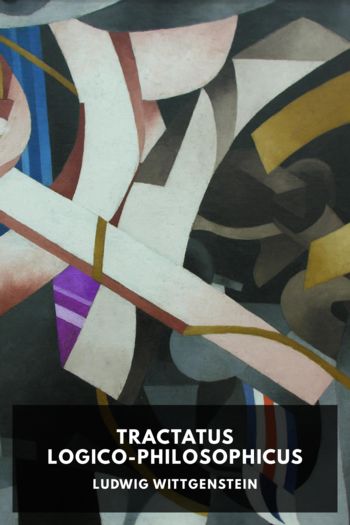Tractatus Logico-Philosophicus - Ludwig Wittgenstein (top 10 ebook reader TXT) 📗

- Author: Ludwig Wittgenstein
Book online «Tractatus Logico-Philosophicus - Ludwig Wittgenstein (top 10 ebook reader TXT) 📗». Author Ludwig Wittgenstein
And it is obvious that the “⊃” which we define by means of “~” and “∨” is identical with that by which we define “∨” with the help of “~”, and that this “∨” is the same as the first, and so on.
5.43That from a fact p an infinite number of others should follow, namely, ~~p, ~~~~p, etc., is indeed hardly to be believed, and it is no less wonderful that the infinite number of propositions of logic (of mathematics) should follow from half a dozen “primitive propositions.”
But the propositions of logic say the same thing. That is, nothing.
5.44Truth-functions are not material functions.
If e.g. an affirmation can be produced by repeated denial, is the denial—in any sense—contained in the affirmation? Does “~~p” deny ~p, or does it affirm p; or both?
The proposition “~~p” does not treat of denial as an object, but the possibility of denial is already prejudged in affirmation.
And if there was an object called “~”, then “~~p” would have to say something other than “p”. For the one proposition would then treat of ~, the other would not.
5.441This disappearance of the apparent logical constants also occurs if “~(∃x).~fx” says the same as “(x).fx”, or “(∃x).fx.x=a” the same as “fa”.
5.442If a proposition is given to us then the results of all truth-operations which have it as their basis are given with it.
5.45If there are logical primitive signs a correct logic must make clear their position relative to one another and justify their existence. The construction of logic out of its primitive signs must become clear.
5.451If logic has primitive ideas these must be independent of one another. If a primitive idea is introduced it must be introduced in all contexts in which it occurs at all. One cannot therefore introduce it for one context and then again for another. For example, if denial is introduced, we must understand it in propositions of the form “~p”, just as in propositions like “~(p∨q)”, “(∃x).~fx” and others. We may not first introduce it for one class of cases and then for another, for it would then remain doubtful whether its meaning in the two cases was the same, and there would be no reason to use the same way of symbolizing in the two cases.
(In short, what Frege (Grundgesetze der Arithmetik) has said about the introduction of signs by definitions holds, mutatis mutandis, for the introduction of primitive signs also.)
5.452The introduction of a new expedient in the symbolism of logic must always be an event full of consequences. No new symbol may be introduced in logic in brackets or in the margin—with, so to speak, an entirely innocent face.
(Thus in the Principia Mathematica of Russell and Whitehead there occur definitions and primitive propositions in words. Why suddenly words here? This would need a justification. There was none, and can be none for the process is actually not allowed.)
But if the introduction of a new expedient has proved necessary in one place, we must immediately ask: Where is this expedient always to be used? Its position in logic must be made clear.
5.453All numbers in logic must be capable of justification.
Or rather it must become plain that there are no numbers in logic.
There are no preeminent numbers.
5.454In logic there is no side by side, there can be no classification.
In logic there cannot be a more general and a more special.
5.4541The solution of logical problems must be neat for they set the standard of neatness.
Men have always thought that there must be a sphere of questions whose answers—a priori—are symmetrical and united into a closed regular structure.
A sphere in which the proposition, simplex sigillum veri, is valid.
5.46When we have rightly introduced the logical signs, the sense of all their combinations has been already introduced with them: therefore not only “p∨q” but also “~(p∨~q)”, etc. etc. We should then already have introduced the effect of all possible combinations of brackets; and it would then have become clear that the proper general primitive signs are not “p∨q”, “(∃x).fx”, etc., but the most general form of their combinations.
5.461The apparently unimportant fact that the apparent relations like ∨ and ⊃ need brackets—unlike real relations—is of great importance.
The use of brackets with these apparent primitive signs shows that these are not the real primitive signs; and nobody of course would believe that the brackets have meaning by themselves.
5.4611Logical operation signs are punctuations.
5.47It is clear that everything which can be said beforehand about the form of all propositions at all can be said on one occasion.
For all logical operations are already contained in the elementary proposition. For “fa” says the same as “(∃x).fx.x=a”.
Where there is composition, there is argument and function, and where these are, all logical constants already are.
One could say: the one logical constant is that which all propositions, according to their nature, have in common with one another.
That however is the general form of proposition.
5.471The general form of proposition is the essence of proposition.
5.4711To give the essence of proposition means to give the essence of all description, therefore the essence of the world.
5.472The description of the most general propositional form is the description of the one and only general primitive sign in logic.
5.473Logic must take care of itself.
A possible sign





Comments (0)